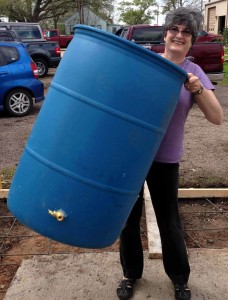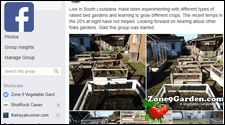Did you know you can get 600 gallons of rainwater for each inch of rain on a thousand-square-foot roof? It’s true! Here is an article I wrote recently for Image magazine:
You probably already have gutters to deal with all the rain we’ve been getting. If so, you’re halfway toward collecting free water to use for your water features, bird baths, gardens or trees.
When you harvest rainwater, you’re simply diverting the water from the roof into strategically placed containers, and it’s amazing how much you can collect. For every inch of rain that falls on one square foot of roof and is guided to a rain barrel, you will get about 0.6 gallon of water. Thus, a 1,000-square-foot roof will yield about 600 gallons of water from just one inch of rain.
 If you decide to harvest this free natural resource (rain water), you can start small by building a simple rain barrel out of a 30- to 72-gallon plastic garbage can. You’ll need a few things from the hardware store such as plastic screening to keep out mosquitoes, a spigot for dispensing the water into your hose or watering can, some caulking, and a PVC pipe elbow for handling any overflow.
If you decide to harvest this free natural resource (rain water), you can start small by building a simple rain barrel out of a 30- to 72-gallon plastic garbage can. You’ll need a few things from the hardware store such as plastic screening to keep out mosquitoes, a spigot for dispensing the water into your hose or watering can, some caulking, and a PVC pipe elbow for handling any overflow.
Rich Tillman of Brazoria (Texas) calculates that building your own rain barrel will cost about 60 cents for each gallon of capacity.
“The storage tanks are the main expense,” Tillman says. “In most guttered homes it takes very little modification.”
As a Master Gardener, Tillman helps with that organization’s rain barrel systems that service many of the experimental gardens and other areas. The simplest of these is a converted garbage can set underneath the condensation drain of an air conditioner.
Of course, you can go with a much larger system, placing barrels at several gutter downspouts or piping several together to deal with the abundance at a single gutter. Whatever system you use, it’s important to secure it so it can’t turn over on someone, and that the people around you realize that it’s not drinking water.
“Plants love rainwater because it doesn’t have the salts and minerals that you might find in tap water or well water,” says John Gordy, Brazoria County Extension Agent – Agriculture and Natural Resources.
With up to half of water use in urban areas used for landscape irrigation and about 50 percent of that water lost due to inefficiencies and improper operation, according to Texas A&M University, it pays to harvest rainwater.
It will reduce your water bill now and in the future. The Texas population is expected to grow by 82% in the next half-century, increasing demand greatly in an already strained public water supply.
You’ll find many resources by searching for “rainwater harvesting” at http://aggie-horticulture.tamu.edu/
This article republished with permision and is copyright 2014 Image magazine


